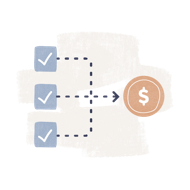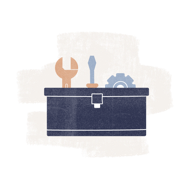The primary difference between is that a loan is an installment account, while a line of credit is a revolving account. With a loan, you receive the money immediately and repay it over a predetermined period. A line of credit works like a credit card, allowing you to repeatable borrow and repay against your credit limit.
Small business owners often turn to loans and lines of credit to finance different types of business operations. Both options can give you access to capital to run and grow your business, but their terms make them useful in different scenarios. These types of financing are also available to non-business owners.
Whether you’re looking for help with business or personal finances, you’ll want to consider the differences between a loan and lines of credit and the different terms available with either option.
Loans Versus Line of Credits: The Basics
Generally, a loan offers a lump sum payout with fixed repayment terms — it’s best when you need an exact amount of money and a predictable budget.
A line of credit is all about options as you can choose when and how much to borrow, and can borrow against your credit line multiple times — but your draws may have higher rates than you’d receive with a loan and their variable rates can lead to unpredictable payments.
Installment Loans
When a creditor approves your loan application, it will offer you a specific loan amount, interest rate, and repayment schedule. If you accept the loan, you may need to pay an origination fee, which is often a percentage of the loan’s amount that’s taken out of the money you receive or added to the amount you repay.
With a loan, you’ll receive the entire amount upfront and then make periodic (often monthly) payments to repay the loan plus interest. Your account is closed once you repay the loan, and you’ll need to apply for a new loan if you need to borrow more money.
Revolving Lines of Credit
When you’re approved for a line of credit, you’ll have a new account with a maximum credit line and interest rate. A credit line gives you the option to take out loans (or “draws”) against your credit line, which you’ll then repay plus interest over time. There may be a minimum draw amount, but you won’t necessarily be required to borrow money if you open a credit line.
You can take multiple draws against your credit line as long as the total balance doesn’t go beyond your credit limit. Also, because it’s a revolving account, you can borrow against your credit line multiple times as you pay down your draws.
However, some lines of credit have an initial draw period when you can take draws and make minimum payments. After the draw period, you’ll enter a repayment period and will have to pay off the balance before it ends.
Different Terms for Loans and Lines of Credit
Both installment loans and revolving lines of credit are available to individual borrowers and business, and either option can come with various terms. Understanding the differences between the interest rate types, personal and business accounts, and collateral requirements is an important step in knowing which type of financing will work best for you.
Fixed vs. Variable Rates
Loans and lines of credit are available with either fixed or variable rates, but fixed rates are more common on installment loans while lines of credit tend to have variable rates.
A fixed interest rate means that the rate you accept is set in stone. Having a fixed rate may be best if you want certainty, as you’ll know your monthly payments won’t change.
Variable rates often start lower than fixed rates on the same type of account, which is why they can be appealing. However, the rate may rise or fall in the future, which means your monthly payment could increase.
In either case, the initial rate will depend on your (or the business’s) creditworthiness, the lender, and the specifics of your loan. A Nav account gives you free business credit scores and a free personal score from Experian.
Personal vs. Business Loans and Credit Lines
Many small business owners initially finance their business with personal loans or lines of credit. When applying for a personal loan or line of credit, the creditor (such as a bank or online lender) will solely look at your personal finances to determine if you’re approved and your rates and terms.
Your personal credit scores, credit history, debt-to-income ratio, and other outstanding debts can all come into play. In turn, taking on the debt can also impact your ability to qualify for more personal financing in the future — even if you don’t plan on using the funds for your business. Also, you’ll personally be responsible for all of the debt.
A business loan or line of credit is lent with the specific purpose of helping a business. As a small business owner, your personal creditworthiness may be a factor in getting approved. But creditors will also consider the business’s credit reports, credit scores, bank statements, and overall finances.
Some business lenders may require a minimum revenue requirement or only offer loans to established businesses. And depending on the size and history of your business, you may need to sign a personal guarantee for a business loan or credit line.
With a personal guarantee, you’ll be legally liable for the debt if the business can’t afford to repay the loan. Even so, you may find it’s easier to get approved for higher loan amounts or credit limits, and keeping your finances separate can be a good idea regardless of the personal guarantee.
Although it’s not always an option when you’re just starting out, using personal financing for personal purposes and business financing for business purposes is often a good approach.
Secured vs. Unsecured Loans and Credit Lines
You can find both secured and unsecured options for personal and business financing. In either case, an unsecured loan means a creditor is offering you money based on your promise to repay the loan.
Falling behind on unsecured loan payments can lead to fees and hurt your credit. The creditor can also sue you or the business, and may be able to take money from your paychecks, freeze or take money from bank accounts, and get judgment liens against your personal or business property.
Secured loans require collateral, which is something of value that the creditor can take if you don’t repay the loan. But even with collateral, falling behind can lead to fees and hurt your credit, and the creditor can still file a lawsuit if the collateral’s value doesn’t cover the balance.
An auto loan or mortgage are examples of secured personal loans. Similarly, business loans that are taken out to purchase a specific piece of equipment — fittingly called equipment financing — may be secured by that equipment.
More general secured business loans may require a blanket lien, giving the creditor the right to the business’s assets, inventory, equipment, and accounts receivable if the business doesn’t repay the loan.
Unsecured loans aren’t as risky because you won’t lose physical assets if you can’t repay the loan. However, because secured loans are safer for creditors, you might be able to get more favorable terms with a secured loan.
Small Business Loan vs. Small Business Line of Credit
Small business loans and lines of credit are two popular business financing options. A business loan may be a good option if you have a specific project in mind: purchasing a new piece of equipment, expanding to a new location, or buying out a competitor.
A line of credit could be best if you tend to find yourself short of working capital and need help managing unsteady cash flow. Being able to tap your credit line could help you quickly ramp up before a busy season starts, or cover your bills through a slow season.
Business credit cards can also help with short-term financing, but a line of credit may have a lower interest and could be a better option if you’ll need more than a few weeks to pay off the purchases. Some vendors also don’t accept credit cards, or charge you a fee to use one.
| Small Business Loan | Small Business Line of Credit | |
| Interest Rate | Generally fixed | Generally variable |
| Collateral | Secured or unsecured | Secured or unsecured |
| Pros |
|
|
| Cons |
|
|
| Best for: | Starting or growing a business when you have a specific need for financing. | An ongoing project that will need multiple payments, or as a tool to manage cash flow. |
Home Equity Loan vs. Home Equity Line of Credit
Home equity loans (HELs) and home equity lines of credit (HELOCs) are personal debts that are secured by your home. For many people, their home is their most valuable assets, and one of the few things they can use as collateral to qualify for a large loan.
However, you’re also putting your home at risk as the creditor could foreclose on the property if you can’t afford the payments anymore. The process can also take time and be expensive as you may need to get your home appraised to take out a HEL or HELOC.
| Home Equity Loan | Home Equity Line of Credit | |
| Interest Rate | Generally fixed | Generally variable |
| Collateral | Secured by your home | Secured by your home |
| Pros |
|
|
| Cons |
|
|
| Best for: | One-time home renovation, maintenance, or improvement projects. | An ongoing home renovation, maintenance, or improvement project. |
Personal Loan vs. Personal Line of Credit
A personal loan or line of credit may be more appropriate if you don’t need to borrow money for your business. But in some cases, you might want (or need) to use a personal loan or line of credit for your business.
Both options are often unsecured and may offer low rates for borrowers who have good to excellent credit. There are also unsecured options for those who have poor credit, but watch out as they may have ultra-high interest rates that could leave you in a debt trap.
Secured options also exist, but they often have a specific name. For example, auto loans, mortgages, pawn loans, and payday are examples of secured personal loans. One exception is when you use money in a savings account to secure a personal loan or line of credit — it will continue to earn interest, but you won’t be able to use the funds until you repay the loan.
| Personal Loan | Personal Line of Credit | |
| Interest Rate | Generally fixed | Generally variable |
| Collateral | Generally unsecured | Generally unsecured |
| Pros |
|
|
| Cons |
|
|
| Best for: | Specific purchases when you don’t want to use collateral. Or, when you can consolidate higher-rate debts. | You don’t know how much money you need, or know you’ll need to take a series of draws. |
Nav’s Final Word: Line of Credit vs. Loan
Once you understand the differences between a line of credit and loan, it’s easier to identify which type of financing fits your circumstances.
Neither is best in every situation, but generally, loans are best when you quickly need a lot of money and want a predictable repayment period. A line of credit can help when you want the option to borrow money and can manage a more volatile repayment process.
No matter which option you choose, compare your loan and line of credit options to make sure you’re getting the best rates and terms possible.
This article was originally written on February 13, 2020 and updated on June 25, 2020.



Have at it! We'd love to hear from you and encourage a lively discussion among our users. Please help us keep our site clean and protect yourself. Refrain from posting overtly promotional content, and avoid disclosing personal information such as bank account or phone numbers.
Reviews Disclosure: The responses below are not provided or commissioned by the credit card, financing and service companies that appear on this site. Responses have not been reviewed, approved or otherwise endorsed by the credit card, financing and service companies and it is not their responsibility to ensure all posts and/or questions are answered.